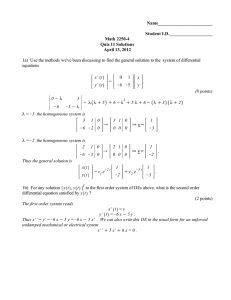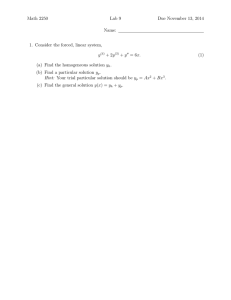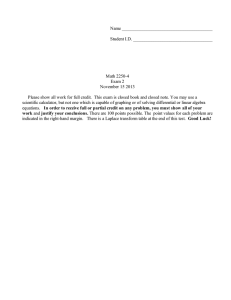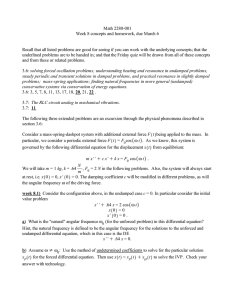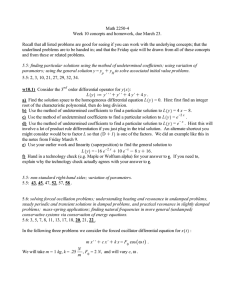Math 2250 Lab 10 Name/Unid: Due Date: 20 November 2014
advertisement
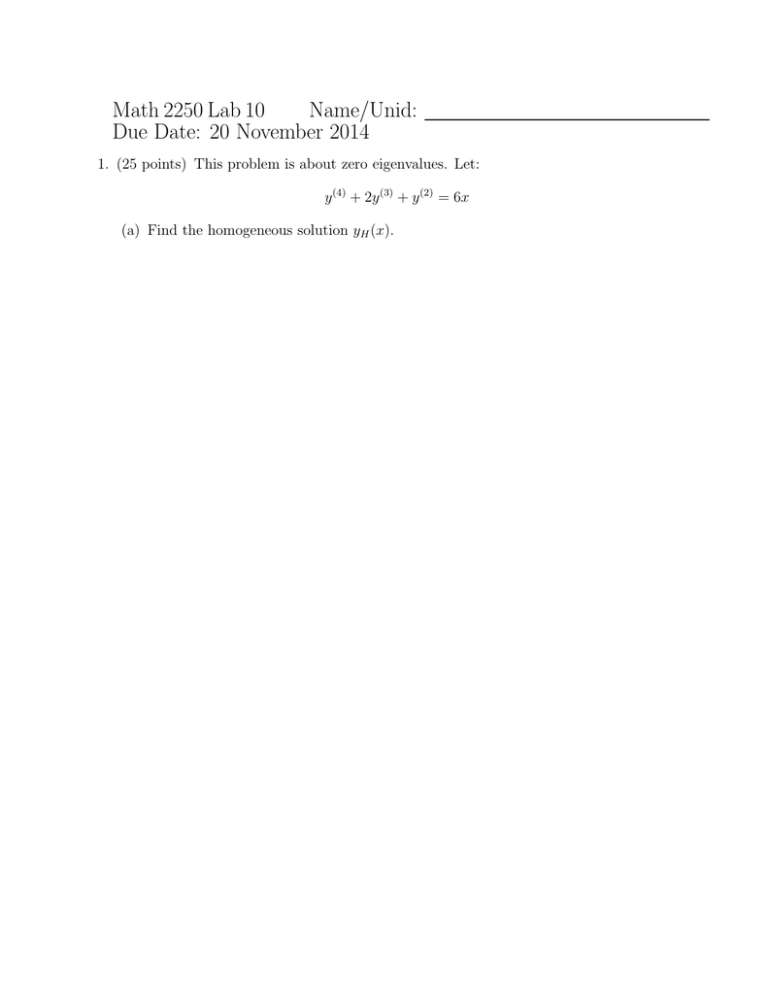
Math 2250 Lab 10 Name/Unid: Due Date: 20 November 2014 1. (25 points) This problem is about zero eigenvalues. Let: y (4) + 2y (3) + y (2) = 6x (a) Find the homogeneous solution yH (x). (b) Find a particular solution yP (x). Hint: Try yP (x) = Ax2 + Bx3 . (c) Find the general solution y(x) = yH (x) + yP (x). Page 2 2. (25 points) Consider the following series RLC circuit: R V L C Suppose a periodic voltage source v(t) = V0 cos(ωt) is applied to the circuit. Using Kirchoff’s laws, the following differential equation gives the charge q(t) of the capacitor. L · q 00 (t) + R · q 0 (t) + 1 · q(t) = V0 cos(ωt) C Take L = 1 V · s · A−1 , R = 0 Ω, C −1 = 0.36 V · C−1 , and V0 = 3 V. Note: the left sides of these equations involve variables, while the right sides involve units. Assume the following initial conditions for q(t): q(0) = 0 q 0 (0) = 0 (a) What is the natural angular frequency ω0 of this system? Hint: ω0 is the angular frequency of the solutions to the unforced equation L · q 00 (t) + R · q 0 (t) + Page 3 1 · q(t) = 0 C (b) Assume that ω 6= ω0 . Use the method of undetermined coefficients to solve for the particular solution qP (t). Then use q(t) = qP (t) + qH (t) to solve the initial value problem for q(t), where qH (t) is a solution to the homogeneous (unforced) equation. You may wish to use a computer to check that this solution is correct. Page 4 (c) Write down the specific case of the solution q(t) (found in part b) for ω = 0.5. Compute the period of this solution, which is a superposition of two cosine functions. Use Matlab, Maple, or other technology to graph one period of the solution. What phenomenon is somewhat exhibited by this solution? Page 5 (d) Now let ω = ω0 . Use the method of undetermined coefficients to solve for a new particular solution qP (t). Then use q(t) = qP (t) + qH (t) to solve the initial value problem for q(t). Graph this solution over the interval 0 ≤ t ≤ 60 seconds. What phenomenon does this solution exhibit? Page 6 3. (25 points) Consider the same RLC circuit as in problem 1. For this problem, take L = 1 V · s · A−1 , R = 1.2 Ω, C −1 = 0.36 V · C−1 , V0 = 3 V, and ω = 1. This gives us the differential equation: q 00 (t) + 1.2q 0 (t) + 0.36q(t) = 3 cos(t) (a) Use the method of undetermined coefficients to find a particular solution qP (t) to this differential equation. Page 7 (b) Use the particular solution qP (t) found in part (a) and the solution qH (t) to the corresponding homogeneous equation to write down the general solution to this differential equation. Identify the “steady periodic” and “transient” parts of this general solution. Page 8 (c) Given the initial conditions q(0) = 0 q 0 (0) = 0 solve the resulting initial value problem for q(t) satisfying the differential equation at the beginning of this problem (you may use technology to do this). Page 9 (d) Graph, on a single plot, the IVP solution found in part (c) as well as the steady periodic solution identified in part (b). Choose a time interval so that you can clearly see the convergence of the IVP solution to the steady periodic solution. Page 10 4. (25 points) The Laplace transform is a function L which takes as input a function of time f (t) and outputs a function F (s) by the rule: Z ∞ f (t)e−st dt L(f )(s) = F (s) = 0 Transform methods are very useful for solving differential equations, but a physical relationship between F (s) and f (t) is not immediately clear. The goal of this problem is to give intuition for the variable s. (a) Consider the following functions: f1 (t) = −1 : 0 ≤ t ≤ 1 +1 : 1<t f2 (t) = cos(2t) f3 (t) = sin(3t) Find the Laplace transforms F1 (s), F2 (s), F3 (s) of these functions. It should be straightforward to compute F1 (s) by hand, but you should look up F2 (s) and F3 (s) in a table or use a computer. Page 11 (b) For each of the Laplace transforms found in part (a), replace the variable s by iω. Here i is the imaginary number i2 = −1, and ω is a real number that represents a frequency. Page 12 (c) If z = x + iy is a complex number, its complex conjugate is z ∗ = x − iy. The non√ negative real number |z| = zz ∗ is called the magnitude of z. Find the magnitude of F1 (iω), F2 (iω), and F3 (iω). Hint: For this problem, the complex conjugate of F (iω) is F (−iω), and eix = cos(x) + i sin(x). Page 13 (d) Plot the magnitudes |F1 (iω)|, |F2 (iω)|, and |F3 (iω)|. Can you relate these plots to the frequency of f2 (t) and f3 (t)? Based on that relationship, what can you say about the frequencies of f1 (t)? Page 14

